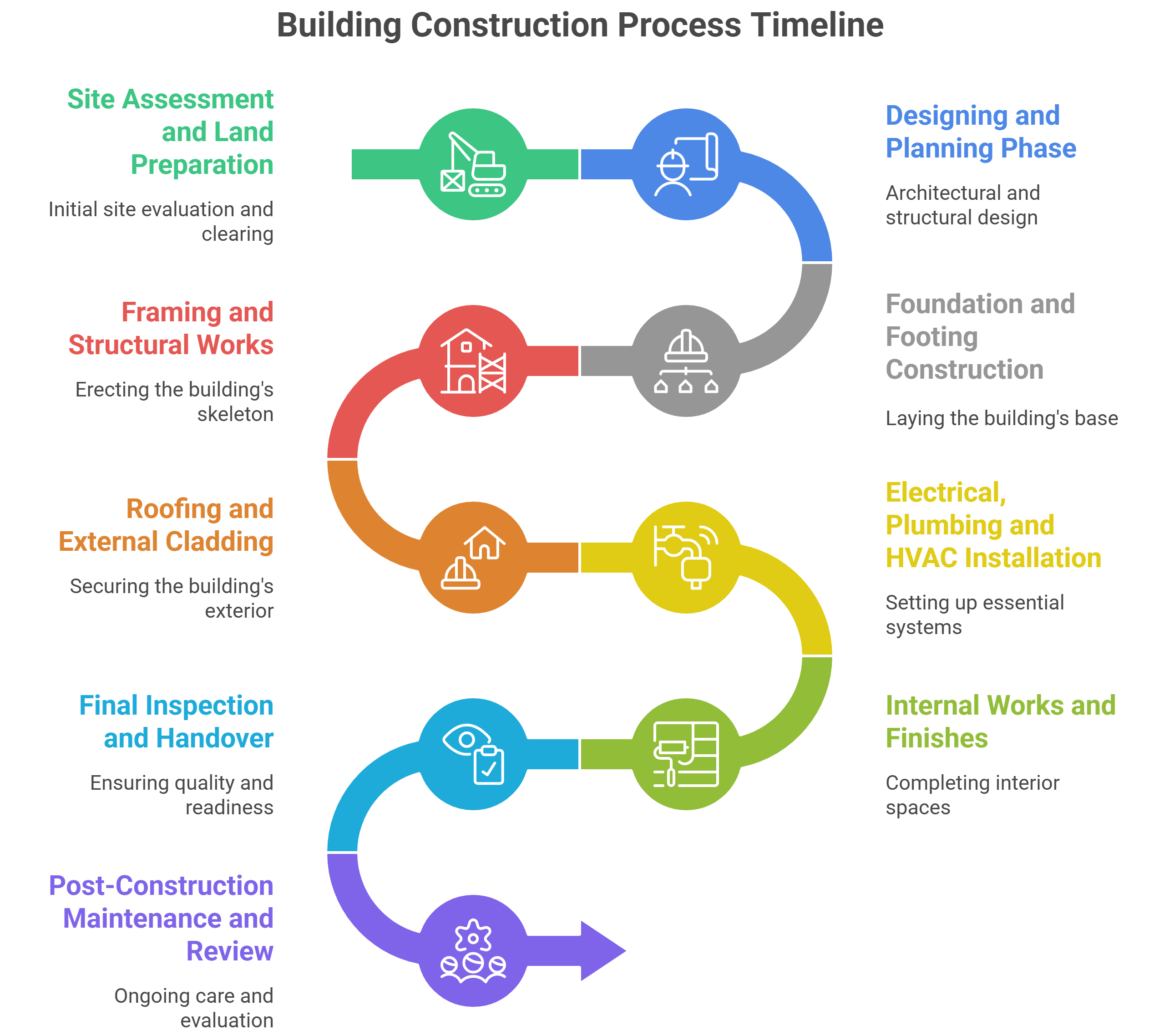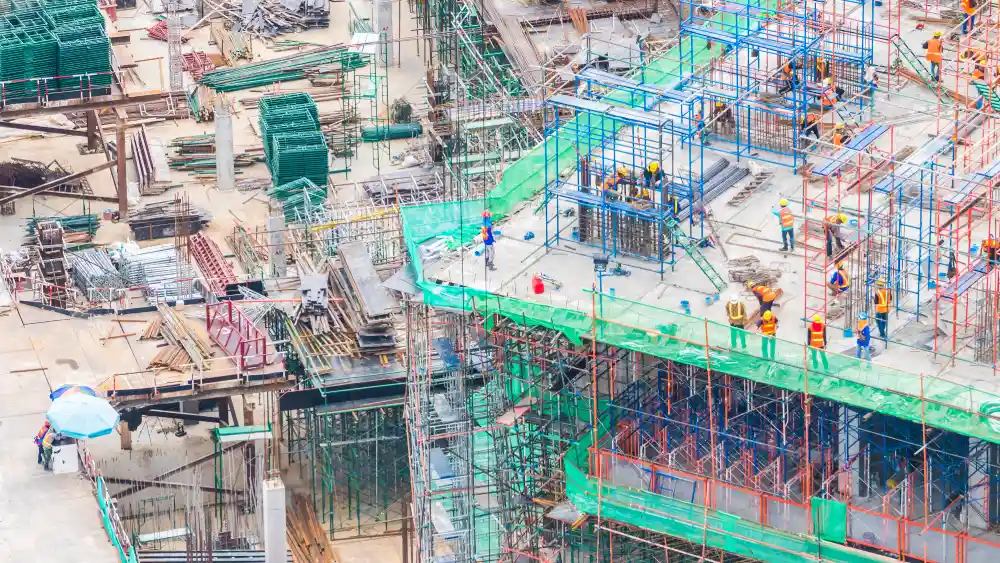Site preparation, foundation laying, structural framing, and final finishing define the core phases of a building construction process from start to finish. Each stage demands coordination among architects, engineers, and contractors. In Australia, efficient sequencing of these steps reduces project delays by nearly 18%, according to Infrastructure Australia.
This guide breaks it down simply, helping homeowners or students grasp the essentials without overwhelming details.

Site Assessment and Land Preparation
Understanding the land’s unique characteristics kicks off any successful project, as thorough evaluations reveal potential risks like unstable soil or flood zones that could derail timelines. Experts rely on geotechnical reports to assess bearing capacity and groundwater levels, preventing costly surprises later.Complete Process of Building Construction from start to finish
In fact, CSIRO research shows over 35% of project delays in Australia trace back to inadequate early site checks, underscoring the need for professional input right away. Once assessments confirm viability, crews move to practical preparations that create a safe, workable canvas for building. This involves clearing vegetation, levelling the terrain, and establishing access points for machinery. Key tasks include:
- Soil compaction and drainage check
- Temporary fencing and signage
- Utility mapping and removal of obstacles These steps lay the groundwork for a smooth building construction process from start to finish, minimising environmental impacts.
Designing and Planning Phase
Architects and engineers collaborate to turn ideas into detailed blueprints, where every dimension and material choice aligns with local council requirements and client needs. Incorporating tools like Building Information Modelling enhances precision, allowing virtual walkthroughs before ground is broken.
The timeline for construction project often hinges on these elements, with Australia’s ABS 2024 statistics indicating an average residential phase spanning 8-12 weeks; this period integrates feedback loops for revisions, ensuring the final plans support efficient execution.
Foundation and Footing Construction
Digging deep into the earth begins the critical base layer, where excavators remove soil to precise depths based on engineering specs, followed by formwork that shapes poured concrete into sturdy footings. Reinforced bars distribute loads evenly, adapting to site-specific factors like clay expansion in Australian soils.
This phase demands vigilance to avoid voids or weak spots that compromise the entire building construction process from start to finish. Statistics reveal over 60% of structural failures link to rushed or flawed foundations, highlighting why compaction testing is non-negotiable. Builders conduct rigorous checks throughout, such as:
- Soil bearing test verification
- Concrete curing monitoring
- Waterproofing inspection These measures safeguard against settlement issues, promoting longevity in diverse climates from coastal humidity to inland aridity.
Framing and Structural Works
Erecting the framework transforms the site into a recognisable shape, with timber or steel beams forming walls, floors, and roof supports that transfer weights downward efficiently. Bracing elements add lateral stability, crucial for withstanding winds common in regions like Queensland.
This stage ties directly into energy codes, incorporating insulation early to boost thermal performance and reduce future utility bills in the overall building construction process from start to finish.
Roofing and External Cladding
Selecting durable coverings protects the interior from elements, starting with roof trusses topped by materials such as Colorbond steel or terracotta tiles that offer superior UV resistance in Australia’s harsh sun. Installation focuses on secure fixings and flashing to prevent leaks, while cladding like brick veneer or fibre cement panels adds weatherproofing and aesthetic appeal.
Exterior finishes account for 12-15% of total costs, balancing protection with visual harmony in the building construction process from start to finish.
Electrical, Plumbing and HVAC Installation
Integrating essential services turns a shell into a functional space, with electricians routing wires for outlets and lights, plumbers laying pipes for seamless water flow, and HVAC specialists fitting ducts for balanced airflow.
Compliance with standards ensures safety, like grounding to prevent shocks or insulating pipes against freezes in cooler states. This phase coordinates closely to avoid rework, streamlining the building construction process from start to finish.
| System Type | Core Function | Quality Checkpoint |
|---|---|---|
| Electrical | Power circuits, lighting | AS/NZS 3000 standard test |
| Plumbing | Water supply, drainage | Leak and pressure testing |
| HVAC | Climate control | Airflow and filter efficiency |
Internal Works and Finishes
Applying layers of plaster smooths surfaces ready for paint, where low-VOC options minimise health risks while enhancing room ambience with colours suited to natural light. Flooring choices, from timber planks to vinyl tiles, factor in traffic patterns, and joinery like kitchen cabinets customises usability. Sustainable sourcing, such as FSC-certified woods, aligns with green building trends prevalent in Australian homes.
Prioritising these elements polishes the interior for occupancy, with tasks like:
- Cabinet installation
- Tile grouting and sealant test
- Lighting and switchboard connection This attention to detail elevates comfort, ensuring the building construction process from start to finish delivers spaces that feel tailored and enduring.
Final Inspection and Handover
Reviewing every component verifies readiness, from checking door alignments to testing smoke alarms, culminating in a defect-free report that satisfies building codes. Handover involves walking clients through operations, providing manuals, and activating warranties for peace of mind.
Effective Construction Project Management plays a key role here, with 90% of Australian builders adopting digital tools to track issues swiftly and maintain transparency in the building construction process from start to finish.
Post-Construction Maintenance and Review
Establishing ongoing care routines preserves the investment, scheduling tasks like gutter cleaning or HVAC filter changes to catch wear early. Structural warranties cover defects, while asset tracking logs performance data for informed upgrades. Proactive approaches can slash long-term repair expenses by up to 25%, fostering sustainability and value retention beyond the initial building construction process from start to finish.
Conclusion: From Vision to Completed Build
Mastering the building construction process from start to finish weaves expertise and collaboration into structures that adapt and thrive over time. It’s about turning calculated steps into homes or offices where daily life unfolds effortlessly, blending innovation with reliability to meet tomorrow’s demands head-on.


